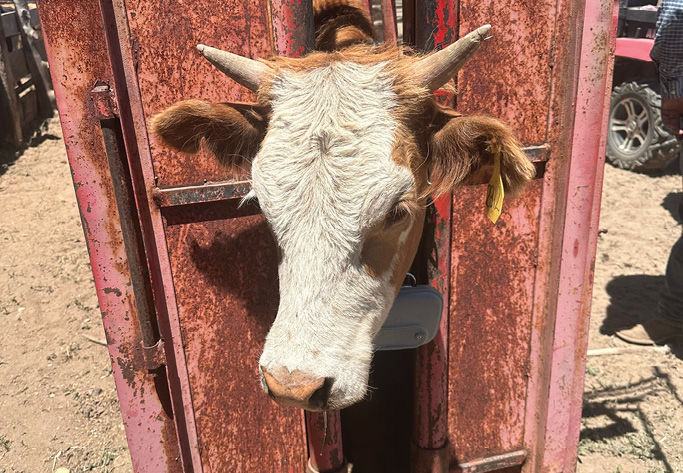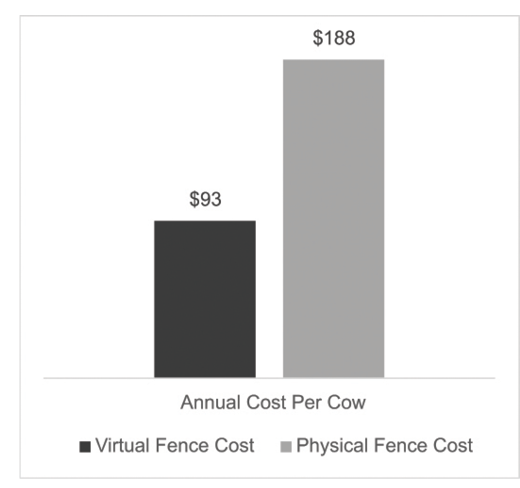Guide B-133
Pilja Vitale, Marcy Ward, Jeff Vitale, Craig Gifford, Santiago Utsumi, and Casey Spackman
College of Agricultural, Consumer and Environmental Sciences, New Mexico State University
Authors: Respectively, Extension Economist, Department of Extension Economics, New Mexico State University (NMSU); Extension Specialist, Department of Animal Sciences and Natural Resources, NMSU; Associate Professor, Department of Agricultural Economics, Oklahoma State University; Associate Professor, Department of Animal Range Science, NMSU; Associate Professor, Department of Animal Range Science, NMSU; and Assistant professor and Extension Range Management Specialist, Extension Animal Sciences and Natural Resources, NMSU. (Print Friendly PDF)

Photo by Kim Crumbley, 2023.
Introduction
In the first publication of this series,4 we explained the operation and features of Virtual fence. The purpose of this factsheet is to guide New Mexico livestock producers when deciding whether virtual fence makes economic sense for their ranching operation. This focuses on a typical large-size ranch in Southeast New Mexico, since a majority of New Mexico’s beef cattle production (74%) occurs on ranches with at least 2,000 acres of pasture.6 Smaller ranches, with a herd size of less than 200 head, require different virtual fencing technology addressed in a companion factsheet.
Soaring costs of traditional metal fencing force ranchers to find alternatives when replacement becomes necessary. For example, building a 4-wire metal fence has increased by at least 50% over the past few years, costing upwards of $15,000 per mile.2 Virtual fencing can be a cost-effective option, especially on larger ranches where fencing needs can become overwhelming. Beyond providing a lower-cost fencing option, virtual fencing provides ranchers with additional benefits that in many cases could justify its use even if fence replacement is not an immediate priority. These benefits include: (1) reducing cattle gathering time, (2) keeping cattle off environmentally sensitive areas, and (3) improved forage productivity by installing interior fences.3
Physical versus Virtual Fence Cost Comparisons
Based on the NM livestock enterprise budget,5 we assumed a ranch with 360 head of cattle operating with 6,000 acres of private land and 75 miles of physical fence. Access to public grazing land is available, which carries 280 Animal Unit Yearlong (AUY), approximately the size of 17,920 acres assuming a stocking rate of 64 acres per cow. Its total operating ranch size is taken to be 23,920 acres.
1.1 Physical Fence Costs for a Large Size Ranch
Physical fence construction costs are taken as $15,000 per mile for the representative New Mexico ranch. This cost is based on custom-built fence costs,2 since fence costs vary with terrain, geography, boundary shape, etc. For example, in mountainous areas with uneven or rocky terrain, labor costs can increase, which in turn raises the overall fencing cost. In contrast, a perfectly square acre requires less fencing than an irregularly shaped one, decreasing the fencing cost for the square acre. A cost calculator is available that can be used to adjust costs to specific ranch conditions. The total cost of constructing the physical fence would be $1,125,000 ($15,000 x 75 miles). Annual repair and maintenance costs are assumed 2% of the initial fence construction cost,1 which is expected to average $22,500 per year, for a total repair and maintenance cost of $562,500 ($22,500 x 25 years).
The useful life of the physical fence is typically 25 years. Depreciating the fence’s construction and annual maintenance costs over its 25-year service life, and assuming zero salvage at the end of its service life, results in an annual charge of $45,000 (Table 1). Placed in more relatable terms, physical fence costs an average $188 per cow annually.
|
Table 1. Annual straight-line physical fence cost |
||||
|---|---|---|---|---|
|
Item |
Cost |
Annual |
Annual Costs |
Annual Costs |
|
Construction |
$1,125,000 |
$45,000 |
$45,000 |
$125 |
|
Repair & Maintenance |
$562,500 |
- |
$22,500 |
$63 |
|
Total |
$1,687,500 |
$45,000 |
$67,500 |
$188 |
|
Note: Based on the representative ranch with 75 miles of fence with a herd size of 360 and a 25-year service life. |
||||
1.2 Virtual Fence (VF) Costs for a Large Ranch
There are two main components to a virtual fencing system: one is the communications, and the other is the e-collar worn by the cattle. The heart of the communications is a locally installed Long Range Wide Network (LoRaWAN) station, or tower, that facilitates communication between the rancher and the cattle’s e-collar. The range of the LoRaWAN tower is highly site-specific: hilly terrain prevents signals from reaching the e-collars in valleys, especially where there is dense forest. A typical ranch in this area of New Mexico will need four towers to completely cover its 6,000 acres of private land, allowing 24/7 communication with their cattle. While using public land, the rancher may or may not have access to complete 24/7 LoRaWAN tower coverage but is expected to maintain daily contact with the herd.
LoRaWAN towers are expected to last 10 years and cost $10,000 each. Annual straight-line depreciation is $1,000. For this ranch, four towers will be provided to cover their 6,000 acres of private land, so the total annual tower cost would be $4,000. Virtual fencing also requires e-collars that need to be replaced every few years or so (Table 2). E-collar costs vary by brand, with some companies leasing e-collars on an annual basis while others require ranchers to purchase collars. Assuming an e-collar unit price of $200 and a five-year service life, the total e-collar cost (360 heads x $40/collar x 2 collars for 10 years) is $28,800. The straight-line depreciated cost is $2,880 per year. A pair of batteries are required to power the e-collars and are purchased separately. They typically last a year but expected life depends on use. The required pair of batteries cost $20 each, so the example ranch will pay $7,200 per year to equip their 360-cow herd. E-collar and battery loss are assumed to be 1% each, with annual costs of $144 and $80.
Labor is required throughout the year to maintain the LoRaWAN towers, e-collars, and batteries. The labor cost to set up and maintain the tower is $21,600 (=$12/hour x 180 hours for 10 years) with an annual cost of $2,160. Twice a year labor is required to change out batteries and maintain e-collar performance. Labor costs for gathering the herd are expected to be $1,200 and $3,000 for the e-collar and battery maintenance. All told the total virtual fence cost is $333,760, the straight-line depreciated annual cost is $33,376, and the annual cost per cow is $92.71 (Table 2).
|
Table 2. Virtual Fence total and straight-line depreciated annual costs. |
|||||
|---|---|---|---|---|---|
|
Item |
Unit Cost |
Qty |
Total Cost |
Annual Cost |
Annual Cost |
|
LoRaWan Tower |
$10,000 |
4 |
$40,000 |
$4,000 |
$11.11 |
|
Collars |
$200 |
720 |
$144,000 |
$14,400 |
$40.00 |
|
Collar loss (1%) |
$200 |
7.2 |
$1,440 |
$144 |
$0.40 |
|
Batteries |
$20 |
3,600 |
$72,000 |
$7,200 |
$20.00 |
|
Battery loss (1%) |
$20 |
36 |
$720 |
$72 |
$0.20 |
|
Labor: maintenance |
$12 |
1,800 |
$21,600 |
$2,160 |
$6.00 |
|
Labor: Herd |
$1,200 |
20 |
$24,000 |
$2,400 |
$6.67 |
|
Labor: |
$3,000 |
10 |
$30,000 |
$3,000 |
$8.33 |
|
Total |
- |
- |
$333,760 |
$33,376 |
$92.71 |
|
Notes: 1) Based on over a 10-year service life for the representative ranch with 360 cows. 2) Collar and battery loss requires the purchase of an additional 1% of collar and battery quantities at the same purchase price as new ones. |
|||||
1.3 Cost comparison between physical fence and virtual fence
From Table 1 and Table 2, the cost of virtual fencing is 24% of physical fencing. In terms of cost, virtual fencing has an advantage over physical fencing. However, cost alone cannot explain all New Mexico ranchers’ choices (Figure 1).


Figure 1. Annual Costs between Virtual Fence and Physical Fence on an annual (left) and per-cow (right) basis.
1.4 Cost comparison between different fence lengths
We now compare the costs of physical fences and virtual fences with 30 miles, 75 miles, 100 miles, and 125 miles fences for a 360-cow herd and 25-year physical fence life. Figure 2 below shows that the longer the fence, the greater the cost advantage virtual fencing has over physical fencing. Only the smallest ranch considered would not benefit from the lower cost of virtual fencing.

Figure 2. Annual cost comparison of Physical Fences versus Virtual Fences by fence length
2. Virtual Fencing Industry Resources
The following are contact information of Virtual Fencing industries for New Mexico ranches interested in Virtual Fencing.
Gallager: Sarah.Adams@Gallagher.com
Gallager: Sharl.Liebergreen@Gallagher.com
Nofence: sales.us@nofence.no
Halter: theo.beaumont@halter.co.nz
Vence: ContactVence@merck.co
3. Opportunities to cost sharing for installing Virtual Fencing with USDA grants
The following seven government programs share the cost of installing Virtual Fencing.
3.1 Agricultural conservation easement program
https://www.nrcs.usda.gov/programs-initiatives/acep-agricultural-conservation-easement-program
3.2 Conservation Innovation Grants
https://www.nrcs.usda.gov/programs-initiatives/cig-conservation-innovation-grants
3.3 Conservation Reserve Program
https://www.fsa.usda.gov/programs-and-services/conservation-programs/conservation-reserve-program/
3.4 Conservation Reserve Enhance Program
https://www.fsa.usda.gov/Internet/FSA_File/crep_for_nra_epas.pdf3.5 Conservation Stewardship Program
https://www.nrcs.usda.gov/programs-initiatives/csp-conservation-stewardship-program
3.6 Environmental Quality Incentives Program
https://www.nrcs.usda.gov/programs-initiatives/eqip-environmental-quality-incentives
3.7 Regional Conservation Partnership Program
https://www.nrcs.usda.gov/programs-initiatives/rcpp-regional-conservation-partnership-program
References
- American Agriculture Economic Association. (2001). Commodity Costs and Returns Estimation Handbook. https://ageconsearch.umn.edu/record/269451?ln=en&v=pdf
- Beiermann, J., Tranel, J.E., & Young, R.B. (May 2024). 2023 Land Rental & Custom Rates for Colorado Farms & Ranches. Colorado State University Extension. https://abm.extension.colostate.edu/wp-content/uploads/sites/61/2024/06/2023-CustomRates-Final-1.pdf
- Blum, B., & Audoin, F. (2024, August 15). Exploring The Boundaries of Virtual Fence. The Rangelands Gateway. https://rangelandsgateway.org/virtual-fence/webinar-1
- Gifford, C., Utsumi, S., Ward, M., Vitale, P., Cox, A., Vitale, J., & Marta, S. (October 2024). Virtual Fencing Using E-Collars on New Mexico Cattle Ranches: Part 1 of 2 (Guide B-132). New Mexico State University Cooperative Extension Program. https://pubs.nmsu.edu/_b/B132/index.html
- New Mexico State University. (2019). Livestock Budgets. Cost and Returns Estimates for Farms and Ranches 2013-2019. https://costsandreturns.nmsu.edu/
- USDA National Agricultural Statistics Service. (n.d.). New Mexico Field Office (Part of the Mountain Regional Field Office). https://www.nass.usda.gov/Statistics_by_State/New_Mexico/Contact_Us/index.php
Read Part 1: Virtual Fencing Using E-Collars on New Mexico Cattle Ranches

This work is supported by the Rapid Response to Extreme Weather Events Across Food and Agriculture Systems (A1712), #2023-68016-38885, from the U.S. Department of Agriculture’s National Institute of Food and Agriculture.
Brand names appearing in publications are for product identification purposes only. No endorsement is intended, nor is criticism implied of similar products not mentioned. Persons using such products assume responsibility for their use in accordance with current label directions of the manufacturer.
To find more resources for your business, home, or family, visit the College of Agricultural, Consumer and Environmental Sciences on the World Wide Web at pubs.nmsu.edu.
Contents of publications may be freely reproduced, with an appropriate citation, for educational purposes. All other rights reserved. For permission to use publications for other purposes, contact pubs@nmsu.edu or the authors listed on the publication.
New Mexico State University is an equal opportunity employer and educator. NMSU and the U.S. Department of Agriculture cooperating.
March 2025 Las Cruces, NM


